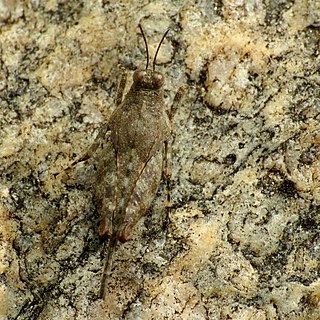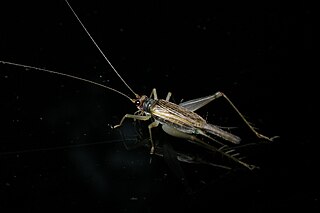
Orthoptera is an order of insects that comprises the grasshoppers, locusts, and crickets, including closely related insects, such as the bush crickets or katydids and wētā. The order is subdivided into two suborders: Caelifera – grasshoppers, locusts, and close relatives; and Ensifera – crickets and close relatives.

Ensifera is a suborder of insects that includes the various types of crickets and their allies including: true crickets, camel crickets, bush crickets or katydids, grigs, weta and Cooloola monsters. This and the suborder Caelifera make up the order Orthoptera. Ensifera is believed to be a more ancient group than Caelifera, with its origins in the Carboniferous period, the split having occurred at the end of the Permian period. Unlike the Caelifera, the Ensifera contain numerous members that are partially carnivorous, feeding on other insects, as well as plants.
Chloealtis is a genus of slant-faced grasshoppers in the family Acrididae. There are about five described species in Chloealtis.

Conocephalus fuscus, the long-winged conehead, is a member of the family Tettigoniidae, the bush-crickets and is distributed through much of Europe and temperate Asia. This bush-cricket is native to the British Isles where it may confused with the short-winged conehead. These two species are phenotypically similar; however, the distinguishing factor between the two is the fully developed set of wings the long-winged conehead possesses that allows for flight. In the short-winged coneheads the hind wings are shorter than the abdomen, causing the wings to be vestigial and the species is incapable of flight. For this reason it is hard to discriminate between the two species during the early stages of their life cycle before the wings have fully developed. The colouration of the conehead is typically a grass green with a distinctive brown stripe down its back, though there are some brown phenotypes.

Paratettix is a genus of ground-hoppers or pygmy grasshoppers, with more than 60 described species found worldwide.

Pentacentrinae is a subfamily of crickets in the family Gryllidae. Sometimes known as 'Silent Litter Crickets', they occur in tropical Asia, Africa and the Americas.

Caedicia simplex is a species of bush cricket, native to New Zealand. It is also found in Australia. Its common name is the common garden katydid.

Metiochodes is an Asian genus of "sword-tail crickets", in the subfamily Trigonidiinae and the tribe Trigonidiini.







